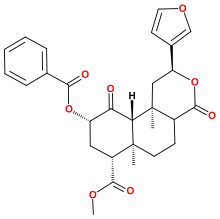Herkinorin
Herkinorin is an opioid analgesic that is an analogue of the natural product Salvinorin A. It was discovered in 2005 during structure-activity relationship studies into neoclerodane diterpenes, the family of chemical compounds of which Salvinorin A is a member.[1]
 | |
| Clinical data | |
|---|---|
| ATC code |
|
| Legal status | |
| Legal status |
|
| Identifiers | |
IUPAC name
| |
| CAS Number | |
| PubChem CID | |
| ChemSpider | |
| ChEMBL | |
| CompTox Dashboard (EPA) | |
| Chemical and physical data | |
| Formula | C28H30O8 |
| Molar mass | 494.53 g/mol g·mol−1 |
| 3D model (JSmol) | |
SMILES
| |
InChI
| |
| | |
Unlike Salvinorin A which is a selective κ-opioid agonist with no significant μ-opioid receptor affinity, herkinorin is a μ-opioid agonist with more than 100x higher μ-opioid affinity and 50x lower κ-opioid affinity compared to Salvinorin A.[2][3] Herkinorin is a semi-synthetic compound, made from Salvinorin B, which is most conveniently made from Salvinorin A by deacetylation, as while both Salvinorin A and Salvinorin B are found in the plant Salvia divinorum, Salvinorin A is present in larger quantities.[4]
A study in primates showed it to act as both a peripherally active μ and κ agonist with a fast onset of action. The study did not find any evidence of central activity in primates and questions whether herkinorin's effects are due entirely to peripheral binding.[5] Unlike most μ-opioid agonists, herkinorin does not promote the recruitment of β-arrestin-2 to the intracellular domain of the μ-opioid receptor, or induce receptor internalization.[6] This means that herkinorin may not produce tolerance and dependence in the same way as other opioids, although some development of tolerance through other mechanisms has been observed,[7] and some other analogues related to herkinorin can recruit β-arrestins.[8]
See also
- Kurkinorin[9]
- Salvinorin B methoxymethyl ether
- RB-64
References
- Wayne W. Harding; Kevin Tidgewell; Nathan Byrd; Howard Cobb; Christina M. Dersch; Eduardo R. Butelman; Richard B. Rothman; Thomas E. Prisinzano (July 2005). "Neoclerodane Diterpenes as a Novel Scaffold for μ Opioid Receptor Ligands". Journal of Medicinal Chemistry. 48 (15): 4765–4771. doi:10.1021/jm048963m. PMID 16033256.
- Kevin Tidgewell; Wayne W. Harding; Anthony Lozama; Howard Cobb; Kushal Shah; Pavitra Kannan; Christina M. Dersch; Damon Parrish; Jeffrey R. Deschamps; Richard B. Rothman; Thomas E. Prisinzano (June 2006). "Synthesis of Salvinorin A Analogues as Opioid Receptor Probes". Journal of Natural Products. 69 (6): 914–918. CiteSeerX 10.1.1.693.6345. doi:10.1021/np060094b. PMID 16792410.
- Kenneth G. Holden; Kevin Tidgewell; Alfred Marquam; Richard B. Rothman; Hernán Navarro; Thomas E. Prisinzano (November 2007). "Synthetic studies of neoclerodane diterpenes from Salvia divinorum: Exploration of the 1-position". Bioorganic & Medicinal Chemistry Letters. 17 (22): 6111–6115. doi:10.1016/j.bmcl.2007.09.050. PMC 2111044. PMID 17904842.
- Kevin Tidgewell; Wayne W. Harding; Mark Schmidt; Kenneth G. Holden; Daryl J. Murry; Thomas E. Prisinzano (October 2004). "A facile method for the preparation of deuterium labeled salvinorin A: synthesis of [2,2,2-2H3]-salvinorin A". Bioorganic & Medicinal Chemistry Letters. 14 (20): 5099–5102. doi:10.1016/j.bmcl.2004.07.081. PMID 15380207.
- Butelman ER, Rus S, Simpson DS, Wolf A, Prisinzano TE, Kreek MJ (October 2008). "The effects of herkinorin, the first mu-selective ligand from a salvinorin A-derived scaffold, in a neuroendocrine biomarker assay in nonhuman primates". The Journal of Pharmacology and Experimental Therapeutics. 327 (1): 154–60. doi:10.1124/jpet.108.140079. PMC 2614932. PMID 18593955.
- C. E. Groer; K. Tidgewell; R. A. Moyer; W. W. Harding; R. B. Rothman; T. E. Prisinzano; L. M. Bohn (February 2007). "An Opioid Agonist that Does Not Induce μ-Opioid Receptor—Arrestin Interactions or Receptor Internalization". Molecular Pharmacology. 71 (2): 549–557. doi:10.1124/mol.106.028258. PMC 3926195. PMID 17090705.
- Heng Xu; John S. Partilla; Xiaoying Wang; John M. Rutherford; Kevin Tidgewell; Thomas E. Prisinzano; Laura M. Bohn; Richard B. Rothman (March 2007). "A comparison of noninternalizing (herkinorin) and internalizing (DAMGO) μ-opioid agonists on cellular markers related to opioid tolerance and dependence". Synapse (Submitted manuscript). 61 (3): 166–175. doi:10.1002/syn.20356. PMID 17152090.
- Tidgewell K, Groer CE, Harding WW, Lozama A, Schmidt M, Marquam A, Hiemstra J, Partilla JS, Dersch CM, Rothman RB, Bohn LM, Prisinzano TE (April 2008). "Herkinorin analogues with differential beta-arrestin-2 interactions". Journal of Medicinal Chemistry. 51 (8): 2421–31. doi:10.1021/jm701162g. PMC 2494883. PMID 18380425.
- Crowley RS, Riley AP, Sherwood AM, et al. (2016). "Synthetic Studies of Neoclerodane Diterpenes from Salvia divinorum: Identification of a Potent and Centrally Acting μ Opioid Analgesic with Reduced Abuse Liability". J. Med. Chem. 59 (24): 11027–11038. doi:10.1021/acs.jmedchem.6b01235. PMC 5189922. PMID 27958743.